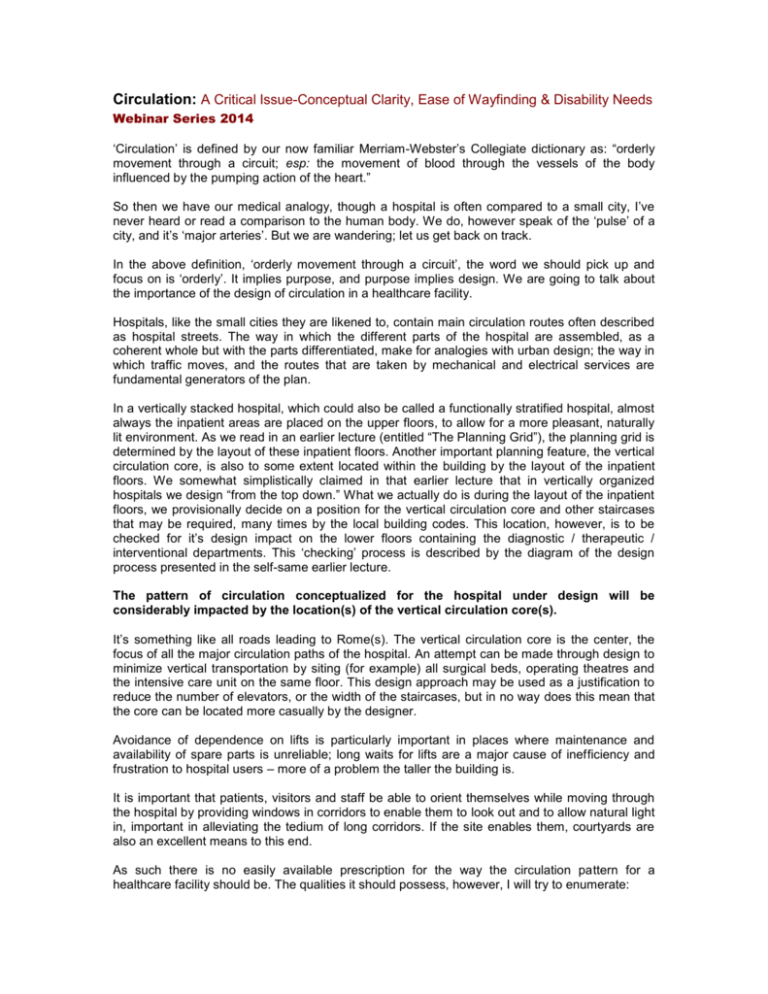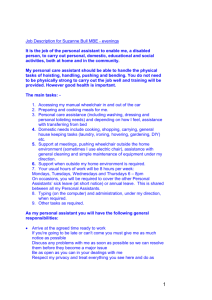Circulation - Healthcare Architecture
advertisement

Circulation: A Critical Issue-Conceptual Clarity, Ease of Wayfinding & Disability Needs Webinar Series 2014 ‘Circulation’ is defined by our now familiar Merriam-Webster’s Collegiate dictionary as: “orderly movement through a circuit; esp: the movement of blood through the vessels of the body influenced by the pumping action of the heart.” So then we have our medical analogy, though a hospital is often compared to a small city, I’ve never heard or read a comparison to the human body. We do, however speak of the ‘pulse’ of a city, and it’s ‘major arteries’. But we are wandering; let us get back on track. In the above definition, ‘orderly movement through a circuit’, the word we should pick up and focus on is ‘orderly’. It implies purpose, and purpose implies design. We are going to talk about the importance of the design of circulation in a healthcare facility. Hospitals, like the small cities they are likened to, contain main circulation routes often described as hospital streets. The way in which the different parts of the hospital are assembled, as a coherent whole but with the parts differentiated, make for analogies with urban design; the way in which traffic moves, and the routes that are taken by mechanical and electrical services are fundamental generators of the plan. In a vertically stacked hospital, which could also be called a functionally stratified hospital, almost always the inpatient areas are placed on the upper floors, to allow for a more pleasant, naturally lit environment. As we read in an earlier lecture (entitled “The Planning Grid”), the planning grid is determined by the layout of these inpatient floors. Another important planning feature, the vertical circulation core, is also to some extent located within the building by the layout of the inpatient floors. We somewhat simplistically claimed in that earlier lecture that in vertically organized hospitals we design “from the top down.” What we actually do is during the layout of the inpatient floors, we provisionally decide on a position for the vertical circulation core and other staircases that may be required, many times by the local building codes. This location, however, is to be checked for it’s design impact on the lower floors containing the diagnostic / therapeutic / interventional departments. This ‘checking’ process is described by the diagram of the design process presented in the self-same earlier lecture. The pattern of circulation conceptualized for the hospital under design will be considerably impacted by the location(s) of the vertical circulation core(s). It’s something like all roads leading to Rome(s). The vertical circulation core is the center, the focus of all the major circulation paths of the hospital. An attempt can be made through design to minimize vertical transportation by siting (for example) all surgical beds, operating theatres and the intensive care unit on the same floor. This design approach may be used as a justification to reduce the number of elevators, or the width of the staircases, but in no way does this mean that the core can be located more casually by the designer. Avoidance of dependence on lifts is particularly important in places where maintenance and availability of spare parts is unreliable; long waits for lifts are a major cause of inefficiency and frustration to hospital users – more of a problem the taller the building is. It is important that patients, visitors and staff be able to orient themselves while moving through the hospital by providing windows in corridors to enable them to look out and to allow natural light in, important in alleviating the tedium of long corridors. If the site enables them, courtyards are also an excellent means to this end. As such there is no easily available prescription for the way the circulation pattern for a healthcare facility should be. The qualities it should possess, however, I will try to enumerate: 1. It should have conceptual clarity. By this I mean it should be designed with purpose, and should not be leftover space or squeezed into the gaps between other areas. Geometry can be a recourse, but it should work with other planning imperatives, and junctions should be uniquely treated to avoid confusion over which corner of the hexagon (for example) you have reached. 2. It should not be boring. Try to make walking from one place to another interesting, modulate those corridors, color them differently, hang artwork along the way. Niches, outside views, courtyards, all these will help. 3. It should enable wayfinding. In combination with well-designed signage and maybe supergraphics, people should be able to find their way to their destination with ease. Color-coding for floors or departments is sometimes used. 4. They should be wide enough to handle anticipated traffic. Stretcher traffic needs 8’-0” width of corridor for easy movement (turning). 7’-0” will work, but use 8’-0” if you can. Corridors between Operation Theaters make sense even with 10’-0” width. There may be a lot of stuff parked along the sides, despite instructions to OT staff to the contrary. 5. They should be indirectly lit. Patients on stretchers get to look at the ceilings. The sign put up by the traffic police at the end of Marine Drive in Mumbai says, “Drive carefully. Hospital ceilings are boring.” While not advocating rash driving, we would advocate making the ceilings interesting. Some of the hospitals currently existing in India have been provided with ramps in addition to the usual elevators and stairs. Power cuts are realities that have to be considered. But consider putting some (two) of the elevators on a generator, if this helps in avoiding the ramp, which is wasteful of space and difficult to use, as the gradient is often excessive. (With an acceptable gradient, the length becomes excessive, considering that the lower floors of hospitals are considerably higher than those of the usual non-hospital building.) When planning for the area occupied by this circulation space (corridors) in the architectural space plan, it can be provided for as a percentage of the department area (usable, built-up area). This percentage will vary depending on the department and may also vary if the architect has any special feature in mind for that department which is not explicitly provided for in the room-by-room area statement (such as semi-covered, landscaped waiting). The percentage can vary from 35% for an Operation Theater Suite (with 8’-0” corridors) to 20 – 25% for the Administration Department. On the Inpatient floors or even in the Outpatient Department, these corridors can be modulated by recessing pairs of doors that occur at regular intervals, and using an accent color in the niche so created. This helps relieve the boredom of walking through long, uninteresting corridors. Very frequently the major circulation paths through the hospital are laid out even before the tentative space allocation for the hospital departments is done. Thus, the importance of conceptualizing these paths in a way that they contribute to the concept and functional layout of the hospital is not to be underestimated, the exercise should not be done casually. Frequently the manner in which the healthcare architect conceptualizes the working (and therefore layout) of certain hospital departments, notably the Operation Theater Suite and the Radiology & Imaging Sciences Department (as described in a later lecture titled “The Architecture of Imaging”) will determine the circulation pattern through that department, and hence affect the layout of circulation paths in contiguous areas of the hospital. Frequently you will find that in the areas below the footprint of the inpatient tower in the podium, you end up using the same corridors that you used in the inpatient floors. (At least I find myself doing this quite often. There must be a good reason for this, I hope there is! Beats me if I can think of it though. Maybe you can think of one.) (Taking the easy way out? Aaaaahh…lets keep it within the profession!) The funda is: Defining major circulation paths through the proposed and future buildings is a design decision that will considerably impact the form, layout and thus the eventual functioning of the healthcare facility being designed. Do it thoughtfully and with conceptual clarity. Special Considerations for Designing for the Disabled Identifying and understanding the conditions which constitute barriers to those with a disability (this category includes, besides the wheelchair bound, those who for any reason have difficulty in walking, and also those with a sensory – that is, visual or hearing – impairment) is a fundamental requirement for the effective provision of accommodation and facilities to be used by disabled people. If the needs of people who have temporary or permanent disabilities are taken into consideration, the resulting design can make the design easier and safer to use for those with children, those using wheeled equipment and those carrying other items. The principle of applying critical criteria should be used – for example, where space is a consideration, wheelchairs or other larger wheeled items need to be considered; for vertical fixtures or fittings, the shorter person and wheelchair user must be considered; and for wayfinding those with visual and hearing impairments must be considered. The resulting design will help not only people who are ill or disabled but also those who are suffering from shock or stress, as many users of health buildings are. Building design that gives consideration to all users will also be easier and safer during an emergency evacuation. The best design philosophy is to consider the journey through the healthcare facility from start to finish, analyzing all the related components of the task (negotiating entrances, corridors, lifts, reception areas, toilets, etc) to ensure that the features, equipment and fittings encountered in completing the journey are suitably designed so that the overall task can be completed easily and conveniently, bearing in mind the different requirements of staff, patients and visitors with varying degrees of functional mobility. In this way building users will be more independent (less reliant upon staff) and consequently less stressed, anxious and frustrated. People with disabilities can be defined as those who, as a consequence of an impairment, may be restricted or inconvenienced in their access to, and use of, buildings because of the physical barriers – such as doors that are too narrow, flights of steps, or unsuitable facilities (for example inadequate lighting, or lack of handrails on staircases or grabrails in toilets.) Some people will be temporarily disabled as a result of their need for hospital treatment. The following categories of building user are generally recognized: 1. Fully-ambulant: persons who are fully physically capable of carrying out all activities necessary to their role or function. 2. Semi-ambulant: persons who walk with difficulty or are otherwise insecure, as a result of a temporary or permanent impairment of the lower limbs. They may walk with or without a walking stick (sticks, crutches, walking-frames, etc) and/or require the assistance of another ambulant person. Some people in this category will, in addition, have reduced strength and dexterity in the upper body and/or a sensory impairment. Semi-ambulant people find it difficult to cover long distances (even 50 M may be too far). Specific design requirements include: short distances; provision of handrails and suitable spaces for taking a rest; and even non-slippery surfaces without any changes in level; 3. Non-ambulant: persons who temporarily or permanently require to use a wheelchair for mobility. They may propel themselves, or be pushed and maneuvered by an assistant who may or may not be needed to assist with other tasks. Some people will be using a wheelchair for the first time due to being in hospital and will be unfamiliar with maneuvering it. Some people who use wheelchairs will, in addition, have reduced strength and dexterity in the upper body and/or may also have sensory impairment. Some will be able to stand on their feet whilst transferring to and from a wheelchair or to and from other facilities (such as a toilet, chair, or bed); others will require assistance to do so (in some cases the use of a hoist). Specific design requirements include the provision of sufficient space for passing and turning; even surfaces without changes in level; and ensuring that any counters, signs, handles, etc are within the user’s range of vision and grasp. 4. Manually-impaired: persons who have a temporary or permanent lack of strength and/or dexterity in the shoulders, arms and/or hands. They may also be semi-ambulant and/or have a sensory impairment. Specific design requirements include doors which are not too heavy, suitably designed handrails and controls, etc. 5. Visually-impaired: persons who are totally blind or partially sighted. Blind people find their way by noticing changes in the textures of floor or wall surfaces and ambient sounds and smells; some also need the help of a cane for orientation and detecting obstacles. Partially-sighted people need plenty of light and the colors of any fixtures or fittings they are trying to locate (or are on their guard against) must stand out plainly in contrast to the background. It must be remembered that vision deteriorates considerably with age. 40year-olds need twice as much light and 60-year-olds three times as much light to see the same object as clearly as a 20-year old. The more strongly an object contrasts with its surroundings, the easier it is to see. However, colors do not have to be garish; subtle changes in color can be aesthetically pleasing, and can fit in with the general décor as well as providing contrast. Different colors in the same tone can appear very similar to people who are color-blind – for example, a strong red and green together can look much the same – and so, contrasting tones, or a combination of tone and color, are very helpful for people with poor sight. Any type of cluttered design should be avoided, for this makes it more difficult for a visually-impaired person to “read” the shape of a space, and consequently impedes their ability to navigate. Good design therefore should not only contribute towards the legibility of a building, but also facilitate easy navigation through it. Specific design requirements include: a simple, well-planned layout even surfaces with tactile indications of direction; no obstructions in walking areas; well-lit areas; signs placed at a convenient height, with space to stand in front to read them. 6. Hearing-impaired: persons who are deaf and hard of hearing have the additional problem that their disability cannot be seen and is therefore not noticed by other people. For effective lip-reading, building areas must be well lit in order that the face of the person speaking is illuminated. Specific design requirements include: a simple, wellplanned layout with well-lit areas; surfaces which dampen ambient noise, signs placed at a convenient height, with space to stand in front; provision of induction loops at reception areas and in auditoria. A check-list giving a suggested sequence of activities to be followed in the planning and design of access and facilities for disabled people is given below: Healthcare Premises: Checklist of Access and Facilities for Disabled People 1. 2. 3. 4. 5. 6. 7. 8. 9. 10. 11. 12. 13. 14. 15. Parking: Are there parking spaces adjacent to the buildings to minimize the distances to be traveled? Is the parking spaces wide enough to allow a car door to open fully to allow unobstructed transfer into a wheelchair, either unassisted or assisted? Is the location of the disabled parking spaces such that the approach route to the building / facility is not obstructed by other parked cars and away from moving traffic? Are kerbs and other changes of level ramped? Is the parking space and access route under cover? Are there adequate signs to identify the reserved parking spaces and the best routes into the premises? Approach to Building: Is the approach route smooth, slip resistant (whether wet or dry), free from incidental obstructions or hazards? Are handrails provided on all slopes and resting places provided at intervals where a ramp or approach is long? Are all public entrances to the building / facility accessible? Are access doors wide enough to facilitate wheelchair movement? Are thresholds eliminated or kept to a minimum? Do door characteristics and dimensions of related spaces allow it to be opened (and closed) easily by independent wheelchair users, moving in either direction? What doors can be eliminated? Internal Circulation: Are lobby sized adequate and safe for both independent and assisted wheelchair use? Are corridor and approach routes satisfactory? Do they allow passing and turning and take adequate account of corridor traffic conditions? 16. 17. 18. 19. 20. 21. 22. 23. 24. 25. 26. 27. 28. 29. 30. 31. 32. 33. 34. 35. 36. 37. 38. 39. Have all obstructions and projections from walls (or ceiling) or similar hazards at floor level – such as changes of level – been avoided? If unavoidable are they clearly discernible? Are internal door widths adequate to allow turning through 90 0 from the corridor or lobby? Should either of both be increased? Have safety handrails been provided on corridors, ramps, and steps or at other points where they are required by persons with impaired mobility? Have they been produced where they can be used as location aids by visually impaired people? Are any large areas of glass close to circulation areas marked or framed so as to be clearly discernible to partially sighted people? Are seats available at intervals to permit an ambulant disabled and elderly person to take a short rest when faced with long corridors to negotiate? Vertical Circulation: Are staircases safe and optimally comfortable for elderly and disabled people? Are handrail and landing characteristics satisfactory? Are lifts available, conveniently placed, accessible and clearly signed? Are lift controls accessible to the independent wheelchair user? Are the visual and audible signals, alarms and floor designations satisfactory? Are digits embossed and satisfactory for blind or partially sighted persons? Is there a Toilets: Are there correctly designed unisex toilets, that are where a husband and wife may enter the cubicle together, available in the public areas of the premises? Are there suitable cubicles for wheelchair users in other male and female toilets in the building? Do cubicles for wheelchair users provide adequate manoeuvring space within, or are turning space provided outside? Is the level of privacy afforded satisfactory? Are there cubicles available with appropriate grab rails for the use of ambulant disabled people? Are the WC and washbasin arrangements accessible to independent wheelchair users? Are the grab rails, mirrors, towels, door closing bars and other aids placed satisfactorily? Outpatient And Treatment Areas: Can ambulance discharge patients under cover within close proximity to the entrance? Are waiting areas protected from draughts as patients move in and out through the entrance doors? Can patients using wheelchairs (their own or hospital chairs) whilst waiting for treatment, sit with other patients without obstructing the corridors or circulation area? Can patients in wheelchairs use the reception desk conveniently and privately? Are all consulting and treatment areas fully accessible? Are there changing cubicles suitable of wheelchair users, with room for assistance to be given if required? Are refreshment areas accessible to disabled people? Are clear, well lit, signs posted to ensure easy circulation within the building? Are telephones and other public mechanisms accessible to wheelchairs users? Are knobs, dials, switches, handles and other controls operable and within convenient reach? Ward Facilities: Do sanitary facilities offer maximum independence and privacy to disabled patients, both those who will be using wheelchairs and those who have walking difficulties? Is the day room accessible, with a variety of seating heights to help ambulant disabled people? Are all notices easy to see and understand? Are window controls, radio and television and call bells easily reached by disabled patients? Can disabled visitors conduct private conversations with their friends in bed or in the ward? Other features: 40. 41. 42. 43. Could disabled employees work in the building – with particular reference to offices, laboratories, canteen, rest rooms and toilet facilities? Are emergency evacuation routes and emergency exits satisfactory? Are fire alarms readily accessible to the semi-ambulant and wheelchair disabled? Are emergency call facilities installed to summon assistance to remove locations? Are audiovisual alarm signals provided?







